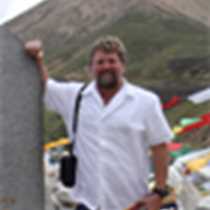Briksdalen
Our wakeup call came early today. At 6am under gray cloudy skies we prepared for our last trip ashore, this time in our third Nordfjord of the expedition. Arriving in the town of Olden at the end of the 109-kilometer-long fjord, the still air over the glass green waters of a nearby glacial lake provided a perfect mirror for the dramatic scenery that enveloped us. Steep gray cliffs laced with waterfalls were wreathed in mist as we made our way towards our objective for the morning—Briksdal Glacier.
Some hiked the trail to the base of the glacier, while others choose to ride the sinuous ribbon of switchbacks on the ominously named “Troll Wagons”. All along the route were majestic vistas, cascading blue-white water and glimpses of glaciers peering down from the great hanging valleys above.
Geological Periods and Epochs collide at the glacier as twisted and fractured sapphire-blue ice tumbles from the shear rock wall above. For ten thousand years the ice has snaked its way to this final spectacular calving site. Squeezing through the valleys, pausing in the corries, this Pleistocene ice grinds away at the pink and gray Caledonian gneiss.
The rock that cradles the glacier formed deep below the Earth’s surface under tremendous differential confining pressure caused by the collision of North America (Laurentia) and Europe (Baltica) ~425-395 million years ago. Ultimately, this and other collisions resulted in the creation of the supercontinent Pangaea. Slow crystallization produced the large sparkling pink potassium feldspar augens (German for “eye”). The differential confining pressure lined the minerals into bands of different colors and chemistry.
Washing ashore at our feet, a large block of ice clearly displays the annual bands of air bubbles that were trapped during the last great Ice Age. Chemical and Isotopic analysis of these bubbles and the ice itself provides scientists with a look back at the make-up of the Pleistocene atmosphere. The effect of changes in the atmosphere are made all the more obvious as we walk from the glacier past signs that mark previous terminal moraines far down slope from the current position. This glacier, like most around the world expanded during the Little Ice Age from 1350 AD to 1880 AD, it has been shrinking ever since. Like ancient trolls, lurking in the forest, the pink feldspar augens watch as we descend the trail bringing to life the inspiration for Norwegian composer Evard Grieg’s masterpiece I Dovregubbens Hall “In the Hall of the Mountain King” from the Peer Gynt Suite.
Assembling with Rich in the Lounge for the laptop gallery, budding photographers awed each other with dramatic, humorous and stunning photos of the expedition. Rick followed with a fascinating lecture “Time with Dogs and The Heritage Trust in the Antarctic” on the history of Antarctic scientific research and his personal efforts to save and conserve the research stations on “The White Continent”. Tonight we gather for the last time at the Farewell Dinner to say goodbye to friends, both new and old, some already making plans for the next great expedition.
Lyrics of the song “In the Hall of the Mountain King” in Peer Gynt, Suite One.
(The troll-courtiers): Slagt ham! Kristenmands søn har dåret.
Dovregubbens veneste mø!
Slagt ham!
Slagt ham!
(a troll-imp): Må jeg skjære ham i fingeren?
(another troll-imp): Må jeg rive ham i håret?
(a troll-maiden): Hu, hej, lad mig bide ham i låret!
(a troll-witch with a ladle): Skal han lages til sod og sø?
(another troll-witch, with a butcher knife): Skal han steges på spid eller brunes i gryde?
(the Mountain King): Isvand i blodet!
Slay him! The Christian's son has bewitched
The Mountain King's fairest daughter!
Slay him!
Slay him!
May I hack him on the fingers?
May I tug him by the hair?
Hu, hey, let me bite him in the haunches!
Shall he be boiled into broth and bree?
Shall he roast on a spit or be browned in a stewpan?
Ice to your blood, friends!




